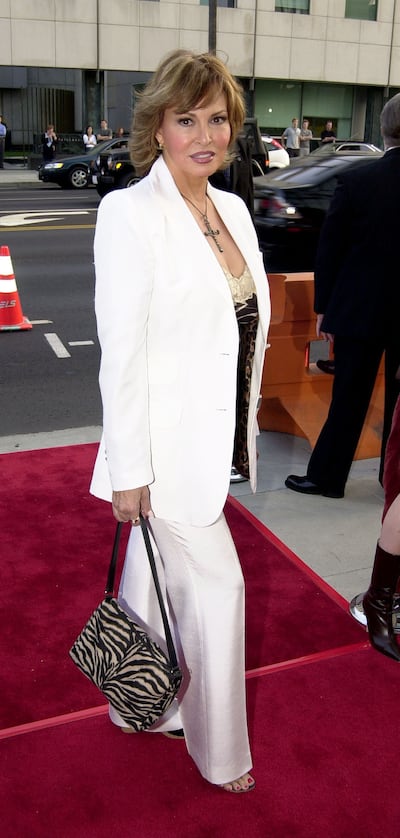Usage guides tell writers to stay away from the word “icon” unless they are describing a devotional painting. But an exception can surely be made for Raquel Welch, who has died in Los Angeles at 82. That status was reconfirmed in 1994 when, during The Shawshank Redemption, Tim Robbins’s dogged prisoner puts the third of three posters over his concealed tunnel.
First, it was Rita Hayworth in Gilda. Second, it was Marilyn Monroe in The Seven-Year Itch. Third, as the film reaches the late 1960s, it was Raquel Welch in One Million Years BC (if he’d lasted another 10 years Farah Fawcett would surely have appeared).
That poster, Welch gazing to middle distance in a deerskin bikini, remains a defining image of the era. It would be a stretch to call it empowering, but Welch appeared active, energetic and aggressive in a way earlier cheesecake pin-ups rarely allowed. The context also added a smidgen of humour. Anyone aware of the plot would know that one of Ray Harryhausen’s stop-motion Tyrannosauruses Rex was waiting just around the outcrop.
[ Raquel Welch: A life in picturesOpens in new window ]
One Million Years BC, released in 1966, was one of the films the young hero went to see in Kenneth Branagh’s recent Belfast. Anyone old enough to remember even adjacent years will remember, for about a decade after that, Welch was – as Bardot and Monroe had been just before – unofficially anointed “the most beautiful woman in the world”. If leering blokes in contemporary situation comedies made a gag about a gorgeous (with apologies) “bird” then Welch was the one they referenced. Nobody since has had quite that hegemony on beauty.
How your mini travel shampoo is costing your pocket and the planet - here’s an alternative
My smear test dilemma: How do I confess that this is my first one, at the age of 41?
The 50 best films of 2024 – the top 10 movies of the year
Paul Mescal on Saturday Night Live review: Gladiator II star skewers America’s bizarre views about Ireland
All of which somewhat overshadowed her gifts as a comic actor and her status as an unrecognised groundbreaker. She was hilarious as the incarnation of Lust opposite Peter Cook and Dudley Moore in Bedazzled (1967). She was positively courageous among the rampaging chaos of Mike Sarne’s take on Gore Vidal’s Myra Breckinridge (1970). Her best performance came as Constance Bonacieux in Richard Lester’s hip, rampaging, adaptation of The Three Musketeers from 1973. She won a Golden Globe for her efforts and deserved a little more than that.
I’ve definitely used my body and sex appeal to advantage in my work, but always within limits
It is also worth noting that – even if the fact was initially not much publicised – Welch, born Jo Raquel Tejada, was a Latina woman in an era where actors of colour were often sidelined (coincidentally, she shared that with Hayworth, formerly Margarita Carmen Cansino). “My father came from a country called Bolivia. He was of Spanish descent,” she was still explaining as late as 2010.
The family moved to California when she was a young child. Her first enthusiasm was ballet, but, told she had the wrong “body type,” she moved on to the gruelling world of beauty pageants. Welch studied theatre at San Diego State College and, not yet 20, married her high-school sweetheart James Welch. To avoid typecasting she worked under her husband’s name.
She secured a bit part in the Elvis film Roustabout and appeared in the TV series Bewitched and The Virginian. Her breakthrough was as one of the scientists who gets shrunk to microscopic proportions and injected into a human body during Richard Fleischer indecently entertaining Fantastic Voyage (1966). That same year One Million Years BC, produced by the British studio Hammer, secured her status for the ages. A heady sixties run ended with the bizarre fiasco that was Myra Breckinridge.
Hard to imagine emerging from any major studio in 2023, the 20th Century Fox release cast Welch as what we would now call a trans woman. “If a man were going to become a woman, he would want to become the most beautiful woman in the world,” the producer noted.

Welch did not get the respect she deserved in later decades. Occasional hits such as The Three Musketeers noted, the Hollywood machine struggled to find material worthy of her comic gifts. But she always retained the affection of the public. And she was game. She was prepared to play herself as bellowing harridan for a hilarious cameo in Seinfeld during the 1990s.
Some years earlier she had won a case against MGM for breach of contract when the company fired her for allegedly refusing early morning rehearsals. Her good spirits were further confirmed when she titled a 2010 self-help book Beyond the Cleavage. Welch had no illusions about how she was perceived.
She was married four times. The last marriage, to Richard Palmer, was dissolved in 2004. Tahnee Welch, daughter by her first husband, was a busy actor in the 1980s and 1990s. Though Raquel Welch had few prominent roles in later decades, she remained a greatly loved figure who represented an increasingly distant age.
A political conservative, she never appeared in anything significantly more revealing than that furry bikini. “I’ve definitely used my body and sex appeal to advantage in my work, but always within limits,” she said. “I reserve some things for my private life, and they are not for sale.”
Yes, an icon unlike no other.






